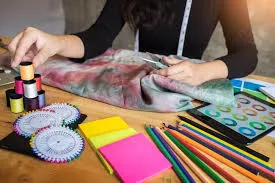When starting out with fabric-based crafts whether sewing, quilting, or simple DIY projects it’s easy to underestimate just how much of a difference the right approach to fabric can make. From choosing the best material to ensuring smooth cuts and tidy finishes, every step you take has an impact on the final result. For beginners, these details can feel overwhelming, but with a few clear, practical tips, you’ll be surprised at how much your projects can improve. This guide is designed to walk you through the essentials, offering advice that’s straightforward and actionable, so you can confidently tackle your next craft with skill and satisfaction.
Understanding Fabric Types: Start with the Basics
The foundation of any successful project begins with understanding the different fabric types available. Fabrics are broadly categorized into natural fibers (like cotton, linen, and wool) and synthetic fibers (like polyester, nylon, and acrylic). Each type behaves differently in crafting projects.
For example, cotton is beloved for its breathability and ease of handling, making it ideal for beginners. In contrast, silk and satin, while beautiful, are slippery and require more careful handling. When working with crafts fabrics, it’s best to start with stable, woven materials before exploring stretchier or more delicate options.
Tip: Always check the fabric’s weight and texture. Lightweight fabrics are great for soft, flowing projects, while heavier fabrics work well for structured designs.
1. Preparing Your Fabric: Pre-Wash and Iron
One of the most overlooked steps in fabric crafting is preparing the fabric before you start cutting or sewing. Many fabrics, especially natural ones, can shrink or change texture after their first wash.
For crafts fabrics like quilting cotton or denim, pre-washing is essential. It not only prevents unwanted shrinkage but also washes out any chemicals left over from manufacturing. After washing, always iron the fabric flat. A smooth, wrinkle-free surface ensures accurate measurements and cleaner cuts.
Tip: If you’re unsure whether a fabric should be pre-washed, do a small test swatch first to see how it reacts.
2. Cutting Fabric Accurately: Tools and Techniques
Cutting may seem simple, but precision here makes all the difference. Uneven cuts can lead to mismatched seams and misshaped projects.
Essential tools include:
- A sharp pair of fabric scissors (not to be used on paper!),
- A rotary cutter and self-healing mat (great for quilting),
- And a set of clear rulers for precise measurements.
When working with crafts fabrics, always lay the fabric out on a flat, clean surface and align it properly with the grainline. Cutting along the grainline helps maintain the fabric’s strength and shape.
Tip: Use pattern weights instead of pins to keep fabric flat while cutting, especially useful for slippery or delicate materials.
3. Handling and Sewing: Reduce Stretch and Fray
Once your pieces are cut, it’s time to handle and sew them with care. Different fabrics require different techniques to avoid stretching or fraying. For instance, woven fabrics generally hold their shape well, but knit fabrics can stretch out of shape if pulled too much.
When sewing crafts fabrics like felt or fleece, which don’t fray easily, you might not need to finish the edges. But for fabrics like linen or chiffon, finishing the seams with zigzag stitches or a serger prevents unraveling.
Tip: Test your sewing machine’s tension and stitch type on a fabric scrap before starting the main project to avoid surprises.
4. Pressing for Professional Results
Pressing your fabric at every stage before, during, and after sewing can make your project look polished and professional. Unlike ironing (where you move the iron back and forth), pressing involves lifting and placing the iron to set seams and remove puckers.
With crafts fabrics, pressing helps flatten bulky seams and shape the fabric into place, especially in quilting projects where precision is key.
Tip: Use a pressing cloth when working with delicate fabrics to avoid scorching or shine marks.
5. Troubleshooting Common Fabric Issues
Even with the best preparation, challenges can arise. Here are some common fabric issues and how to tackle them:
- Fraying Edges: For crafts fabrics prone to fraying, apply a small amount of fray check liquid along the edges or use pinking shears.
- Slippery Fabrics: If the fabric shifts as you sew, use tissue paper underneath to stabilize it, then tear the paper away afterward.
- Puckered Seams: Ensure your needle is the correct size for the fabric; a needle that’s too large can cause puckering.
Tip: Keep a small notebook of fabric notes that worked well, what didn’t so you can learn from each project.
6. Storing and Organizing Fabrics
Proper storage extends the life of your fabric stash and keeps it ready for your next creative burst. Store craft fabrics rolled or folded neatly to prevent creasing, and keep them away from direct sunlight, which can cause fading.
Clear bins or labeled shelves make it easier to find the fabric you need without rummaging, and silica gel packets in storage boxes help prevent moisture damage.
Tip: Keep fabric scraps organized by size or color you never know when a small piece will come in handy for accents or mending!
Conclusion
Working with fabric is one of the most satisfying parts of crafting, offering endless opportunities for creativity and self-expression. By understanding fabric types, preparing and cutting carefully, and using thoughtful sewing and finishing techniques, you can greatly improve your results even if you’re just starting out. Remember, every project is a chance to learn and refine your skills. With patience and practice, you’ll soon find that your fabric creations look cleaner, last longer, and bring even more joy to make.



